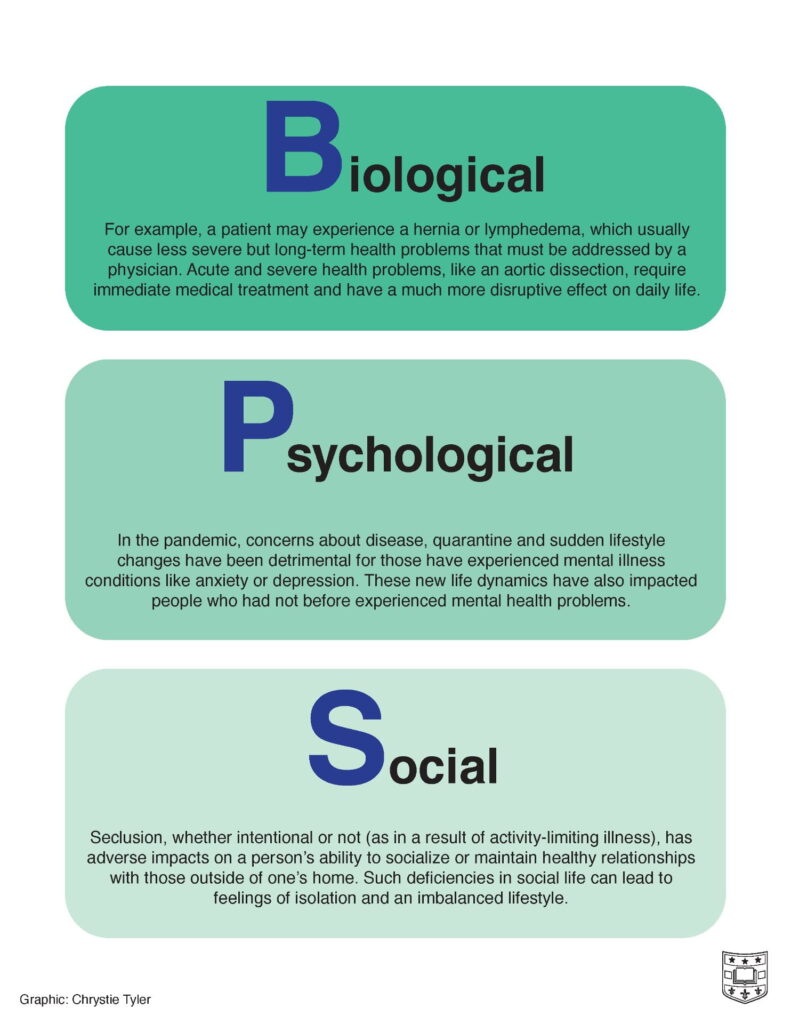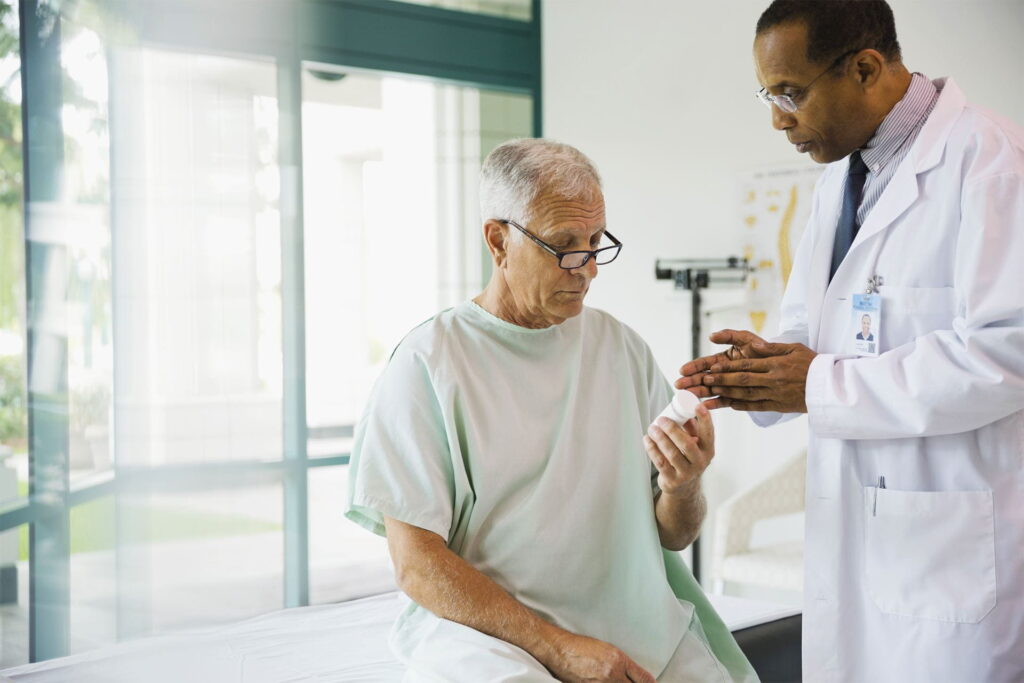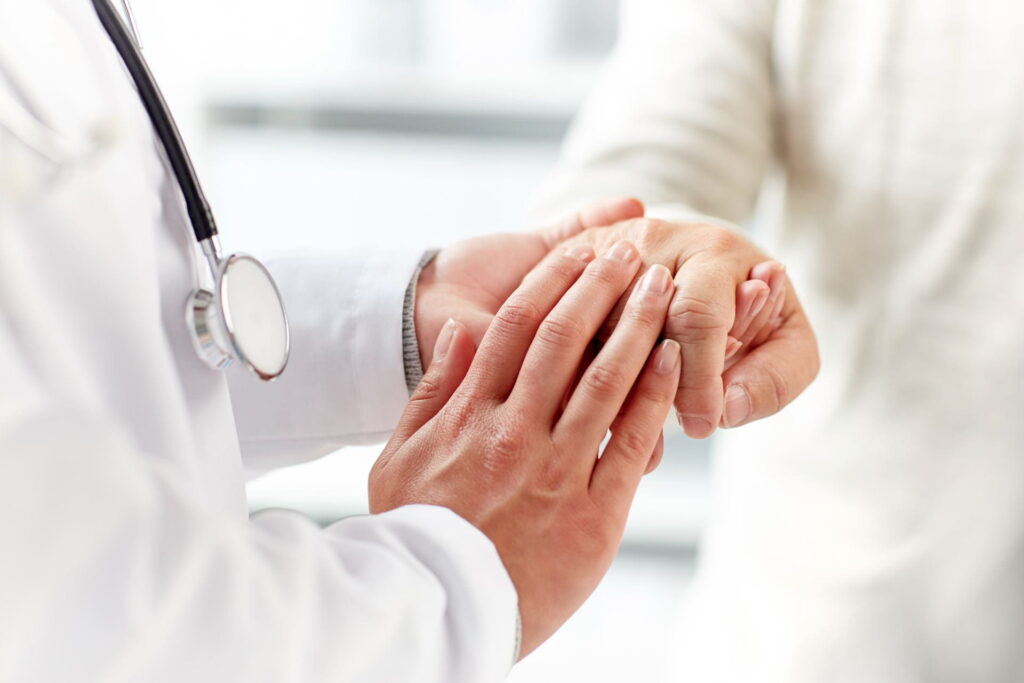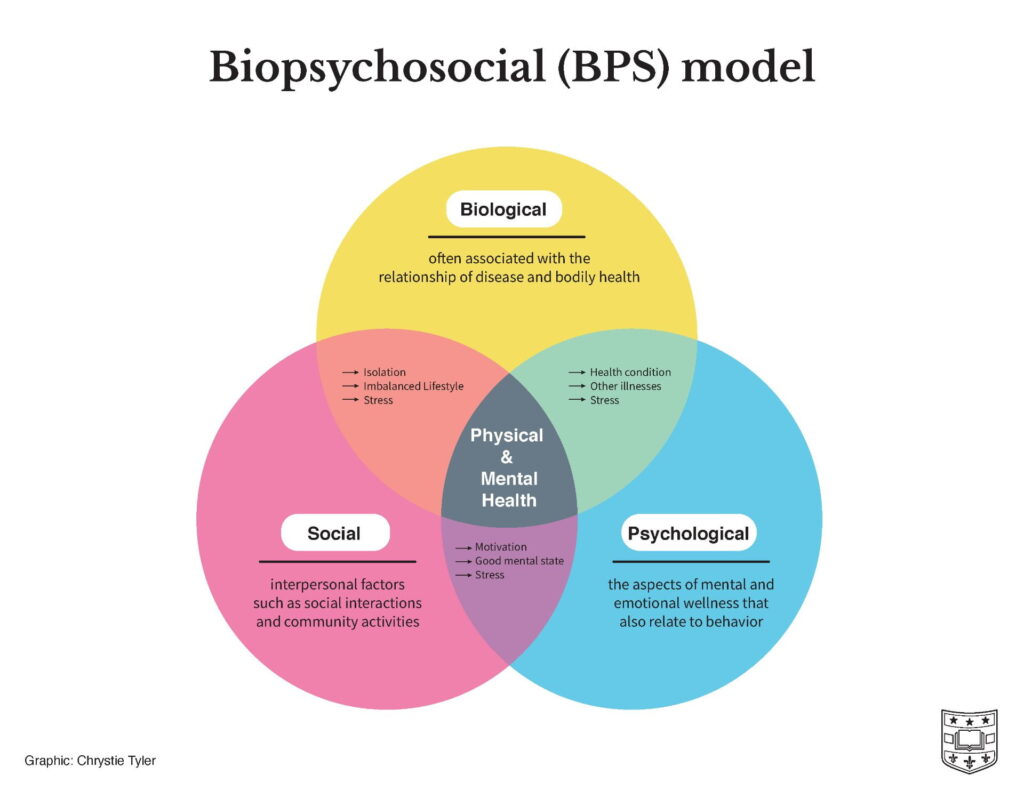The growth of positive COVID-19 cases, surges in hospitalization and the exponential rise of the Delta variant have caused stress in a global community that is already emotionally and mentally taxed from over a year of pandemic stressors. Since early 2020, the strain on individual mental health has led to escalating symptoms and diagnoses of depression and anxiety. Mental health consequences are not limited to the emotions or energy level of a patient; they extend to their physical and social health, as well.
Doctors and scientists alike recognize a relationship between these aspects of our lives – the bodily, the mental, and the social. The “biopsychosocial (BPS) model” emphasizes the interconnection between biological, psychological and socio-environmental factors. When this model is applied to health, it demonstrates the importance of maintaining wellness in all aspects of our lives. It also emphasizes the inseparable relationships between these three factors. When one or more of the trio is disturbed, it can have direct and often negative impacts on the others.
The Biopsychosocial (BPS) Model
The biopsychosocial model of wellness and medicine examines how the three aspects – biological, psychological and social – occupy roles in relative health or disease. The BPS model stresses the interconnectedness of these factors.
A simple breakdown of this application may be as follows:
- The Biological (bio-) – often associated with the relationship of disease and bodily health. For example, a patient may experience a hernia or lymphedema, which usually cause less severe but long-term health problems that must be addressed by a physician. Acute and severe health problems, like an aortic dissection, require immediate medical treatment and have a much more disruptive effect on daily life.
- The Psychological (-psycho-) – the aspects of mental and emotional wellness that also relate to behavior. In the pandemic, concerns about disease, quarantine and sudden lifestyle changes have been detrimental for those have experienced mental illness conditions like anxiety or depression. These new life dynamics have also impacted people who had not before experienced mental health problems.
- The Social (-social) – these are interpersonal factors such as social interactions and community activities. Seclusion, whether intentional or not (as in a result of activity-limiting illness), has adverse impacts on a person’s ability to socialize or maintain healthy relationships with those outside of one’s home. Such deficiencies in social life can lead to feelings of isolation and an imbalanced lifestyle.

The BPS model states that relative health and disease is dependent on the interactions between these three factors. Their interplay thus determines the cause, manifestation and resolution of illness. For example, insults to the bodily health of a patient may be exacerbated by problems in their mental or social spheres of health. Illness may manifest in more extreme or chronic symptoms; it could be harder to treat effectively without addressing the issues outside of bodily health. By moving beyond the biomedical perspective of patient health, the BPS model recognizes the complex dynamic between biological, psychological and social life circumstances, providing a more holistic view to address health problems.
Mental and Physical Health During Episodes of High Stress
The BPS model acknowledges that episodes of stress and poor mental health can contribute to bodily illness. Many people struggle with maintaining mental health during episodes of high stress. An increase in depression and anxiety has been linked to increased risk of infections or illness. Insults to mental health therefore may have contributed to some people’s vulnerability to new physical health problems.

In the reverse, experiencing acute or chronic illness during the pandemic may have also lowered the ability to fight mental stress. Patients undergoing medical treatment during the pandemic have encountered anxiety and depression related to their condition and their access to medical care. Both circumstances are exacerbated by the lack of social interaction and strain of isolation which many have experienced in the past two years.
In circumstances of extreme mental and/or social turmoil, research has found patients show lowered immune systems and healing processes. While rest, good diets and exercise are recommended for those patients healing from a surgery or recovering from an illness, the mental and social spheres of their lives can adversely impact or prolong the healing process. The BPS model thus provides one explanation if a patient is struggling to heal or maintain their health during a prolonged stress event.
Multidimensional Care at Washington University School of Medicine
The biopsychosocial model is a valuable perspective for surgeons during this time of intensive psychological and social stress. Ida Fox, MD, Associate Professor of Plastic and Reconstructive Surgery, is an advocate for this approach and has implemented it since training at University of Rochester Strong Memorial Hospital.
In a previous discussion of her work at Washington University School of Medicine and Barnes-Jewish Hospital: “Practicing biopsychosocial medicine means doing what’s right for the right person at the right time.” Fox considers the patient’s physical condition, psychological status, and social circumstances to provide them with the care ideal to their situation.
In multifaceted cases, surgeons at Washington University assemble multidisciplinary team, including surgeons, physicians, therapists, caregivers, fellows, nurses and researchers to maximize the success of patient health outcome. These many specialists can address different aspects of the patient’s biopsychosocial state. For example, a patient with nerve damage may require the combined efforts of several clinical professionals, like surgeons and neurologists, to help their physical condition. Comprehensive psychological and social healing may be directed with the assistance of therapists and patient educators alongside the supportive work of caregivers back home.
The biopsychosocial model is truly a patient-oriented and thorough method of medicine that has had value in the medical community since its inception. Healing and recovery during – and after – the COVID-19 pandemic is an optimal stage for demonstrating this approach’s benefits to patients.

Washington University Department of Surgery
Doctors in the Department of Surgery at are dedicated to the holistic and successful treatment of their patients. Those experiencing acute or chronic illness are encouraged to review all of their symptoms with their physician to help determine the most effective treatment plan. Patients experiencing mental health problems should also seek clinical care and inform their physician of their symptoms or diagnosed condition.
If you are experiencing a mental health crisis, immediate help is available by phone and online.
24/7 Crisis Hotline: National Suicide Prevention Lifeline Network
www.suicidepreventionlifeline.org
1-800-273- 8255 (Veterans, press 1)
Crisis Text Line
Text TALK to 741-741 to text with a trained crisis counselor from the Crisis Text Line for free, 24/7
Veterans Crisis Line
Send a text to 838255
